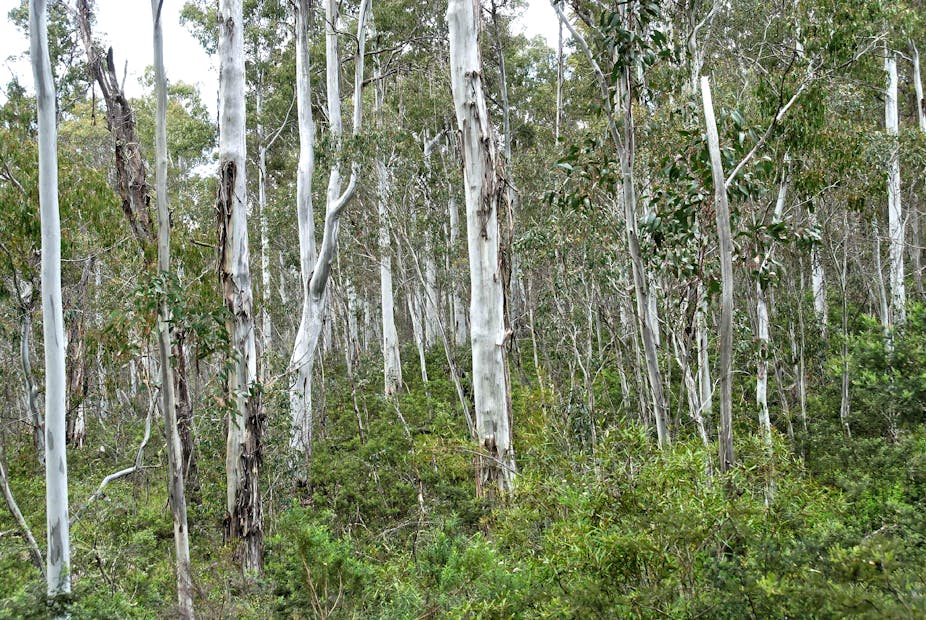In debates about climate change and the mitigation of greenhouse gas emissions, there is a widely-held belief that market mechanisms, like the Labor government’s carbon pricing scheme, will reduce emissions in the cheapest possible way. As a matter of pure theory, this is correct but, in practice, it depends on what is included and excluded from the scheme and how it is designed.
One of the most commonly overlooked sources of carbon abatement is public native forestry, which is currently excluded from the carbon pricing scheme and the government’s offset scheme, the Carbon Farming Initiative. This is despite the fact that stopping the harvesting of public native forests is one of the cheapest ways to reduce Australia’s emissions.
A struggling industry
For the past two decades, the Australian native forest sector has been in decline, primarily because of increased competition in domestic and international wood product markets. Starting in 2008, an already bad situation took a turn for the worse as the global financial crisis choked-off demand for native woodchips and solid wood product consumption slumped.
Since then, the native woodchip sector has struggled to stay afloat, a fact reflected in the financial performance of state forest agencies. For example, over the period 2009 to 2012, the Forests Corporation of NSW (formerly known as Forests NSW) made a total net loss before tax (excluding net fair value adjustment, asset revaluation and impairment of assets) of $85 million, or $21 million per year.
In total, the native forest sector, which takes in growing, harvesting, processing and manufacturing wood products, now accounts for a mere 0.1% of Australian Gross Domestic Product — roughly $1.5 billion per year.
The emergence of carbon markets offers an alternative use for native forests. Rather than chopping them down for little financial return, the forests could be left standing in order to generate carbon credits.
Opportunity for carbon credits
The Australia Institute recently conducted a financial analysis on the Southern Forestry Region of New South Wales, which compared the net financial benefits from harvesting and processing native logs to the net financial benefits that could be derived by using the forests to generate carbon credits.
For the period 2014-2033, the Forestry Corporation of NSW and relevant hardwood processors were estimated to suffer losses of between A$40 million and A$77 million.
In contrast, stopping harvesting could generate 1.7 million carbon credits per year for the NSW Government over the period 2014-2033, and the sale of these credits (accounting for transaction and management costs) is likely to provide net benefits of approximately A$222 million.
The simple message is, if the public native forests of this region continue to be used to produce woodchips and sawnwood, the industry and taxpayers will lose money. If the forests are used for carbon credits, they are likely to return a profit for the community.
Some uncertainties

Of course, any analysis of this nature comes with caveats. For starters, conditions in domestic and international wood product markets could improve, or new markets might emerge, reviving the fortunes of native forest operators. This is possible but unlikely.
There is also the challenge of accessing carbon credits. After recent changes to international accounting rules, stopping or reducing harvesting in native forests will now provide credits that can be used by the Australian government to meet its international mitigation commitments. However, as noted, projects involving stopping harvesting in public native forests are not currently eligible to generate carbon credits under the Carbon Farming Initiative. The federal government is expected to change this rule in the near future and thereby ensure that state governments are able to benefit from improvements in forest management practices.
Finally, even if the Carbon Farming Initiative is expanded to include these projects, there are uncertainties surrounding the calculation of carbon credits and the price they will attract in relevant markets.
Despite these uncertainties, the analysis shows that even under adverse circumstances, using the forests for carbon credits is likely to bring greater financial returns than continued harvesting.
While debate about cutting greenhouse gas emissions usually focuses on the energy sector, the reality is that some of cheapest ways we can cut emissions is through changes in the way we use our forests and landscapes. Preserving native forests is no longer just for tree huggers. The time has come when leaving forests standing makes sense for purely financial reasons.

